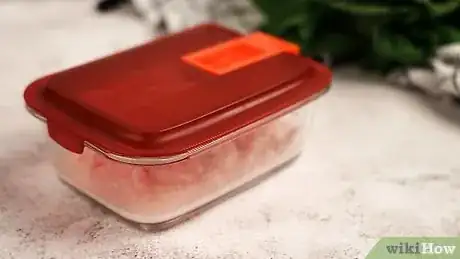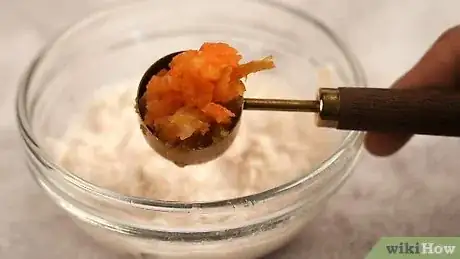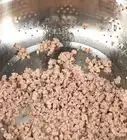This article was co-authored by Monica Moreno, MS, RD, LD/N. Monica Moreno is a Registered Dietitian and the Founder, Owner, and Lead Dietitian at Essence Nutrition in Miami, Florida. Monica specializes in nutrition consulting and school and corporate wellness programs. She holds a BA from The University of Florida and an MS in Dietetics and Nutrition from Florida International University. Monica was the dietitian for the Miami Marlins for close to 5 years, and she is currently visiting dietitian specialist at Ocean Reef Resort and Club. Monica is a member of the Academy of Nutrition and Dietetics, Nutrition Entrepreneurs Dietetics Practice Group, Integrative Nutrition Dietetics Practice Group, Collegiate and Professionals Sports Dietitians Association, and Weight Management Dietetic Practice Group. She was awarded the 2020 Coral Gables Chamber of Commerce Business Woman in Healthcare of the Year award.
There are 9 references cited in this article, which can be found at the bottom of the page.
wikiHow marks an article as reader-approved once it receives enough positive feedback. This article has 15 testimonials from our readers, earning it our reader-approved status.
This article has been viewed 253,529 times.
Whether you're pureeing meat to make baby food or as part of a soft food diet, the goal is to get a smooth, silky consistency. Pasty or lumpy pureed meat isn't appetizing, even for a baby. The key is to chill your cooked meat and puree it when it's cold. Adding some liquid to the meet will help you achieve a more appetizing texture.
Steps
Prepping the Meat
-
1Choose tender cuts of meat. The more tender the meat you use, the smoother and better-tasting your puree will be. Whether you're pureeing beef, chicken, pork or lamb, you want to choose a tender cut that won't toughen up when cooked.[1]
- Often the cheapest cuts of beef are the toughest, so try choosing a cut like top sirloin.
- For chicken, you can buy the meat boneless or bone-in. If you buy it bone-in, you'll have to be careful to make sure no tiny bones get mixed in with the puree.
-
2Cook the meat slowly. Slow cooking methods help the meat retain flavor and moisture, making it much easier to puree. No matter what type of meat you use, consider cooking it slowly so you end up with the best possible texture. Here are some methods that work well:Advertisement
-
3Make sure it's cooked to the correct temperature. The meat must be completely pre-cooked before you puree it. Check the temperature of the meat when it's done to make sure it has reached the correct internal temperature. Here are the correct temperatures for different types of meat:[3]
- Chicken: 165 °F (74 °C)
- Pork: 160 °F (71 °C)
- Beef: 145 °F (63 °C)
- Lamb: 145 °F (63 °C)
-
4Chill the meat thoroughly. After cooking, chill the meat in the refrigerator for at least 2 hours. The meat should be completely chilled in preparation for processing. Chilled meat will process into much finer pieces than meat that is still warm.
-
5Chop it into 1-inch pieces. Remove it from the refrigerator and chop the meat into chunks that will fit easily in your food processor.
Pureeing the Meat
-
1Place a cup of meat in a food processor. If you don't have a food processor, it's fine to use a blender, although the resulting puree may not be as silky-smooth as puree that was made in a food processor.
-
2Blend the meat until it's powdery. "Powdery" may seem like a strange word to describe meat, but that's the texture it will take on when you process it cold. Keep processing the meat until the pieces are very fine, almost like sand.[4]
-
3Add liquid and keep blending. In order to process the meat into a smooth puree, you'll need to add some liquid to loosen it up. You'll need 1/4 cup of liquid per 1 cup of meat, regardless of what kind of meat you're pureeing. Choose from among the following liquids:[5]
- Cooking liquid reserved from cooking the meat
- Sodium-free meat broth
- Water
-
4Store the pureed meat in the refrigerator. After the puree has reached your desired consistency, spoon it into a food storage container with a tight-fitting lid. Store the puree in the refrigerator until use. It will keep safely for three to four days.
- You can freeze pureed meat for later use if desired. Be sure to store it in a freezer-safe container.[6]
- Before serving, let the puree come to room temperature or heat it gently in the microwave.
Trying Variations
-
1Mix in Puree Vegetables pureed vegetables for a baby. You can make a complete pureed meal for a baby by mixing some pureed vegetables in with the pureed meat. This adds flavor and substance. Try the following combinations:
- Chicken puree mixed with carrot puree
- Beef puree mixed with pea puree
- Pork puree mixed with apple puree
-
2Season the meat if it's for an adult. While babies don't need salt and other extra seasonings, an adult might find pureed meat more appetizing if you add some salt and spices. To a cup of any type of pureed meat, add 1/4 teaspoon salt and 1/2 teaspoon of the spices of your choice.
-
3Make chunkier puree. If your baby is getting older and can chew larger chunks of meat, you can make puree with more than one consistency.[7] Instead of pureeing the meat until it's completely smooth, stop when there are still chunks in the puree. As an alternative, add chunks of cooked vegetables to a smooth meat puree.
Expert Q&A
-
QuestionWhen can I puree meat for my baby?
 Monica Moreno, MS, RD, LD/NMonica Moreno is a Registered Dietitian and the Founder, Owner, and Lead Dietitian at Essence Nutrition in Miami, Florida. Monica specializes in nutrition consulting and school and corporate wellness programs. She holds a BA from The University of Florida and an MS in Dietetics and Nutrition from Florida International University. Monica was the dietitian for the Miami Marlins for close to 5 years, and she is currently visiting dietitian specialist at Ocean Reef Resort and Club. Monica is a member of the Academy of Nutrition and Dietetics, Nutrition Entrepreneurs Dietetics Practice Group, Integrative Nutrition Dietetics Practice Group, Collegiate and Professionals Sports Dietitians Association, and Weight Management Dietetic Practice Group. She was awarded the 2020 Coral Gables Chamber of Commerce Business Woman in Healthcare of the Year award.
Monica Moreno, MS, RD, LD/NMonica Moreno is a Registered Dietitian and the Founder, Owner, and Lead Dietitian at Essence Nutrition in Miami, Florida. Monica specializes in nutrition consulting and school and corporate wellness programs. She holds a BA from The University of Florida and an MS in Dietetics and Nutrition from Florida International University. Monica was the dietitian for the Miami Marlins for close to 5 years, and she is currently visiting dietitian specialist at Ocean Reef Resort and Club. Monica is a member of the Academy of Nutrition and Dietetics, Nutrition Entrepreneurs Dietetics Practice Group, Integrative Nutrition Dietetics Practice Group, Collegiate and Professionals Sports Dietitians Association, and Weight Management Dietetic Practice Group. She was awarded the 2020 Coral Gables Chamber of Commerce Business Woman in Healthcare of the Year award.
Registered Dietitian If you and your doctor have decided that the baby is ready for solid foods, then they are ready for pureed meat. Meat is actually the first thing that I gave my son. That is because heme iron, which is the iron that we absorb from animal sources, is the most bioavailable and most absorbable form of iron, and is one of the most critical nutrients that babies need in their diets. Breast milk is very low in iron, so the most important nutrient that we need to supplement with solid foods is iron.
If you and your doctor have decided that the baby is ready for solid foods, then they are ready for pureed meat. Meat is actually the first thing that I gave my son. That is because heme iron, which is the iron that we absorb from animal sources, is the most bioavailable and most absorbable form of iron, and is one of the most critical nutrients that babies need in their diets. Breast milk is very low in iron, so the most important nutrient that we need to supplement with solid foods is iron. -
QuestionHow do I clean the blender?
 Josiah RondeauCommunity AnswerJust run it under some warm water to get the majority of it off. Then, use some soapy water and a scratchy sponge to get under the blades and in the cracks of the blender.
Josiah RondeauCommunity AnswerJust run it under some warm water to get the majority of it off. Then, use some soapy water and a scratchy sponge to get under the blades and in the cracks of the blender. -
QuestionCan I puree scrambled eggs?
 CaeiiaTop AnswererSure. If you cook them a certain way, they'll be soft enough anyway.
CaeiiaTop AnswererSure. If you cook them a certain way, they'll be soft enough anyway.
Warnings
Things You'll Need
- Meat
- Cutting board
- Chef’s knife
- Slotted spoon
- Slow cooker
- Food processor or blender
References
- ↑ http://www.parenting.com/article/baby-friendly-beef
- ↑ https://www.thekitchn.com/10-easy-ways-to-cook-meat-in-the-slow-cooker-216041
- ↑ http://www.foodnetwork.com/recipes/articles/meat-and-poultry-temperature-guide.html
- ↑ http://wholesomebabyfood.momtastic.com/MeatRecipes.htm#.VIoi_2TF8m8
- ↑ http://www.mom365.com/mom/recipes/making-baby-food/perfect-chicken-puree-recipe.aspx
- ↑ https://wholesomebabyfood.momtastic.com/freezepage.htm
- ↑ https://www.webmd.com/parenting/baby/baby-food-milestones#1-3
- ↑ https://www.usda.gov/media/blog/2012/03/22/organic-101-what-usda-organic-label-means
- ↑ https://www.fda.gov/food/people-risk-foodborne-illness/once-baby-arrives-food-safety-moms-be
About This Article
To puree meat, start with a tender cut and cook it slowly by braising it, boiling it, or putting it in a slow cooker. Refrigerate your cooked meat for at least 2 hours, then chop it into 1-inch pieces. Next, put a cup of your meat into your food processor or blender. Blend your meat until it’s fine and powdery, almost like sand. Finally, puree your meat by adding ¼ cup of water, meat broth, or reserved cooking liquid per cup of meat. Continue blending or processing until your puree has reached the consistency you want. To learn how to puree vegetables or make your meat puree chunkier, scroll down!










-Step-25-Version-2.webp)
















































